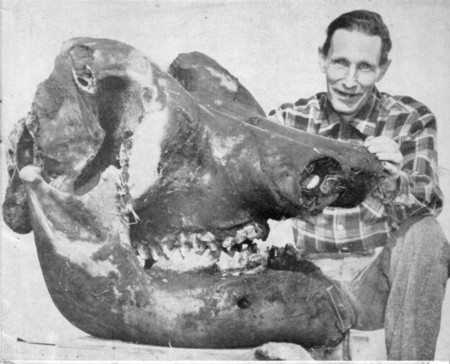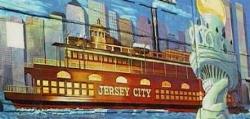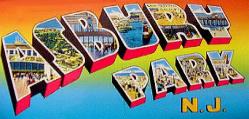 |  |  |
|
| ||
 |  |  |
 |  |  |
|
| ||
 |  |  |
|
|
By Glenn L. Jepsen
Edited by GET NJ, COPYRIGHT 2003

Many mastodon bones and teeth have been found in New Jersey, and many more, now lying a few inches to a few feet below the surface of the land, will be uncovered in the future by natural processes of erosion in stream valleys and along the ocean shore and on the floor of the Atlantic and in man's excavations for buildings and roads and for drainage control. The sites of most of the described discoveries are indicated in the diagram on page 10, but some of the publications about mastodon discoveries don't give enough information for precise map locations. An article printed in 1811 on "Organic Remains of a Former World" stated that mastodon bones had been found "in New Jersey a few miles from Philadelphia," and this may be the earliest record of the "pseudelephant" or "animal incognitum" in New Jersey.
Individual skeletons of noteworthy fossil forms are often given familiar names as a mark of distinction and affection by the people who dig them up and prepare the bones for exhibit, and the mastodon skeleton in Trenton was dubbed Miss Matilda Mastodon by the many people who had a hand in her resurrection. Unfortunately, there isn't enough space here to describe all the details of the discovery or to give proper credit to the scores of people and the many organizations that generously contributed time and energy to the successful cooperative effort of changing Matilda from some old and unknown bones, which had been buried in mire for thousands of years, into a spirited museum treasure that is valuable for knowledge and education. Nor can printed words really express the suspense and excitement and the sounds (digging and scraping noises, off-key singing, occasional shouts of joy and groans of disappointment) as the diggers sought and found the old brown bones and cleaned off the black sticky shroud of swamp muck.
The discovery was a surprise and remarkable accident for, although many mastodon bones had been dug tip previously nearby in southern New York State, and a few had been unearthed in northern New Jersey, no one was looking for old fossils when Matilda came to light. A small lake or pond in a marsh on the property of affable Mr. and Mrs. Gus Ohberg, south of the Highland Lake Road in Sussex County, about 2 miles south of Vernon, was being enlarged by a dragline. It is safe to say that, just before noon on February 19, 1954, the operator, the late Mr. Archibald McMurtry, was not thinking about fossil elephants. He was astonished to see part of a large brown skull, with huge molar teeth and broken stubs of tusks in it, tumble out of a dragline bucket in a load of heavy mud and peat which had been under about eight to twelve feet of water. This is the way Matilda burst out of an obscure antiquity into a very lively present time. Leg bones, the lower jaws, a few ribs and some vertebrae were soon recovered from the mud.
|
|
Mr. Ohberg promptly reported the remarkable and puzzling discovery to the New Jersey State Police of the Department of Law and Public Safety, and they informed Mrs. Kathryn B. Greywacz, Director of the New Jersey State Museum, who phoned the news, that perhaps a mastodon had been found, to me. The happy word of a major fossil find spread rapidly. The next day Dr. Kemble Widmer (then Principal Geologist and now State Geologist of the Bureau of Geology and Topography of the Department of Conservation and Economic Development) and Mr. Frank Markewicz (Geologist) went to the Morristown police barracks and examined the official State Police photos of the lower jaws.
They immediately recognized the teeth as those of a mastodon and this dental identification was soon confirmed by Dr. John Clark (research associate at Princeton University) and Mr. Paul Neimeyer (formerly a preparator at the State Mus- eum) when they arrived to join the digging in the half-frozen muck that the dragline had scooped out of the pond. More people came. All the hones were taken to Mr. Ohberg's nearby filling station and milk bar. Newspaper reporters also showed up, always alert for human interest stories about ancient bones, and quickly published enthusiatic (and exaggerated) accounts of the discovery. Many more people, large and small, families and neighbors, drawn by the printed reports about the Ohberg-Sussex County mastodon, came to see what the excitement was all about. In a couple of days they were arriving in large numbers and at all times of day and night and began to become a source of concern and annoyance to Mr. and Mrs. Ohberg and a threat of damage, through careless handling, to the growing collection of Matilda's mortal remains. In many ways, the scene, with crowds of people expressing awed interest in the fossil bones, was like the scenes of one and two centuries ago when mastodon bones were dug up. Costumes were different, automobiles had replaced horses and carriages, dragline and bulldozer had taken the place of spade and bucket and wheelbarrow. No one mentioned fearsome giant men or terrible and colossal predatory clawed beasts. No one claimed that the mastodon had been shaped like a turtle or that the bones might have moved about after the animal's death or might have been formed in the ground and were never part of a living animal. Knowledge and education had killed some ancient superstitions and fears, but the excitement and pleasure of looking into the past had not changed. No Amer-indians, whose ancestors, had hunted live mastodons, came to watch us bring to life a dead mastodon.
Exposure to the air was beginning to cause the bones to crack and split and flake, and Mr. Ohberg wisely and generously decided to present the specimen to the State Museum. Mr. Meredith Johnson (then State Geologist, now retired) tenderly took the bones to Trenton for restoration and treatment with penetrating plastics and other preservatives. Mr. Charles Lang, formerly a preparator at the American Museum of Natural History in New York, helped with the laboratory work on the specimen.
Cold rains frequently stopped the search for more parts of the skeleton in the peaty material which the dragline had scooped out of the pond, but the staunch searchers continued whenever possible, digging and looking. Everyone and every organization cooperated admirably in the cheerful group effort and enjoyed the work and fun of delving into American prehistory. Mr. Clifford Dennis, Sussex County Superintendent of Schools and Senator George B. Harper, County Engineer, helped with numerous problems, and the Sussex County Road Department supplied men and bulldozers, to move piles of frozen muck, and equipment to pump water out of the pond so that the bottom, could be scraped and examined and probed for traces of the bones that were still missing from the skeleton.
One of the hopes most frequently expressed by the searchers (teachers, geologists, bulldozer operators, students, wives, and casual sidewalk- superintendents who just happened to drop in) was that the tusks, the most interesting parts of the entire skeleton, would be found. A few more bones turned up in the heaps of peat and muck but none were discovered in the bottom of the bog, even in the area that was thought to be the spot the skeleton had originally occupied.
At last, about seven weeks after the skull had dropped from the past into the middle of the twentieth century, both tusks were recovered, in several pieces but in excellent solid condition!
After the bones were cleaned and patched and partly reconstructed in Trenton they were taken to the American Museum of Natural History in New York. There, through arrangements made with Dr. E. H. Colbert, Chairman of the Department of Geology and Paleontology, the skillful and experienced technicians in the "fossil lab," repaired and restored the bones and, with metal supports, placed them in the positions they'd had thousands of years ago when Matilda was peace. fully chewing a mouthful of leaves. Missing bones were cast in plaster, wing other specimens as models. Then the skeleton was dismounted, in sections, and trucked home to Trenton for reassembly, christening, and perpetual display, a proud ad- dition to the State Museum.
The absence of any foot or toe elements (a total of about 70 bones) fused many discussions and led to die speculation that the animal had keen trapped by the bog, had died while standing up, and that the feet were deeper in the mud than any other parts. There was. however, no real evidence to support such a hypothesis. Neither is there any support for the thought that the animal might have drowned after slipping into a deep hole in the peat bog. (Elephants do drown, of course, and two of them perished in the spring of 1847 when their keepers improvidently attempted to swim them across the Delaware River. The skeletons of one of these pachyderms, Pizarro by name, was exceptionally large and was studied and compared, bone by bone, with the skeletons of New Jersey mastodons.)

|
|
| 08/18/2012 11:10 PM |
|
Computer Repair Blog XP Local Area Connection stuck at Acquiring Network Address |
 Your Ancestors' Story |
 Bruce Springsteen's Jersey Shore Rock Haven! |

|
UrbanTimes.com |